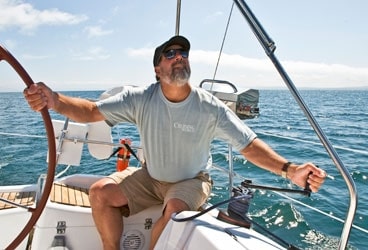
mark pillsbury headshot 1 368
On a brisk fall morning, with an early fall nor’easter headed right for Rhode Island, I decided it was a good day to drop the summer mooring and head to the dock for the winter. I left just before sunrise and motored east. Narragansett Bay was windless and seared with dawn’s colors. Surface fog rose around the boat as I cleared the breakwater, though
soon the sun poked through the clouds to burn off the mist and warm things up. Off to the north, a couple of fishing boats headed for a flock of birds diving on bait fish, but otherwise, I had the bay to myself.
“What a lucky bastard I am,” I thought, watching the early-bird commuters on the Jamestown bridge. But then I spotted the first Styrofoam Dunkin’ Donuts coffee cup being swept along by the incoming tide. A couple of soda bottles and a few plastic shopping bags later, my dream date with Mother Nature was pretty much over; the jetsam kept taking me back to the previous weekend’s seminar at the U.S. Sailboat Show in Annapolis, Maryland, and the darkened ballroom where Mark Schrader and Herb McCormick (see his Sail Green story, “Dying from Seas of Debris,” ) talked about their Around the Americas expedition. Mark is captain of Ocean Watch, the sailboat that carried crew, educators, and scientists from Seattle through the Northwest Passage, around Cape Horn, and back to Seattle in just 13 months. Herb, a CW editor at large and one of four permanent crewmembers, filed frequent blogs and stories for the magazine (see “Closing the Circle,” November 2010), several of which included accounts of environmental calamities they’d witnessed. But like the occasional candy wrapper blown out the window or can that slides off the deck, these could be easily overlooked.
Lace them together, though, as the two did in their slideshow, and these snapshots paint a pretty grim picture of the toll our collective consumption is having on our oceans and the people whose livelihoods depend on them. From the melted permafrost in the arctic to gyres of plastic trash in the Pacific to bays clogged with jellyfish to fjords poisoned by aqua farms, Mark and Herb saw—and photographer David Thoreson documented—some very ugly sights in some of the most beautiful places on the planet.
Discouraged as they were by what they found, though, they were encouraged by many of the people they met, particularly the schoolchildren.
Says Schrader, “Generally speaking, the kids we encountered didn’t seem afraid of information. They were interested in the problems we saw and documented, and their fresh minds seem challenged by such complex issues. Their willingness to spend some mental and physical energy trying to solve problems rather than expressing hopelessness at the scope of it all was encouraging to us. I’m optimistic when I see kids engaged to the point of wanting to be educated about the problems.” When questioned about dumping trash in the ocean, most kids responded by asking, “Why would anyone do that?” Schrader adds, “Most often, their questions cut to the heart of the issue. They were beautifully candid and weren’t tangled up in political webs that we as adults seem to weave into discussions about our environment.”
I thought about that on my trip across the bay, so I have to ask: Who tossed that cup overboard and ruined a perfectly fine morning on the water?
Mark Pillsbury







